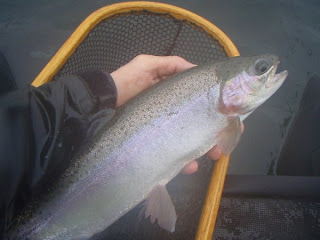Whether you are fishing in Canada, the U.S. or Argentina a trout is still a trout. They all exhibt the same feeding tendencies no matter what hemisphere you are in. This week, during a stay in Southern California, I was able to sample a couple of the local stillwaters. Being December, the local lakes have been stocking rainbow trout, some upwards of over ten pounds. Now there was a time in my life that I totally disregarded this fishing, the unclean pen raised trout were thought as unworthy of my respect. Times have changed, many of the lakes now stock trout that have literally been put on a treadmill of sorts, have mostly full fins, and put up a heck of a fight.
Anyhow I am getting off of the point.
 Lake Cuyamaca is situated in the hills above San Diego at 4000. Most of the fish landed here were on the small side, 10 to 12 inch's, but you do get the occasional fish over 19 inch's. It's a nice drive up there, sometimes you will see turkey and deer on the side of the road. Once you found the fish they were relatively easy to get to bite, midges under the indicator in seven to nine feet of water proved their undoing.
Lake Cuyamaca is situated in the hills above San Diego at 4000. Most of the fish landed here were on the small side, 10 to 12 inch's, but you do get the occasional fish over 19 inch's. It's a nice drive up there, sometimes you will see turkey and deer on the side of the road. Once you found the fish they were relatively easy to get to bite, midges under the indicator in seven to nine feet of water proved their undoing. Miramar lake on the other hand, seems to have fallen through some sort of loop-hole in the stocking process. For whatever reason this lake as been stocked strictly with "Nebraska Tailwalker" rainbows, so we are not seeing any of the standard DFG 10 to 12 inch fish. In this lake the trout have been readily turning to the natural fodder and become quite opportunistic in their feeding habits. Much of the lake is rimmed with tules and at this time with the lake almost full, the outside edge of the tules is about 10 to 12 feet. What this is doing is making the stillwater anglers life a little bit easier by creating a living curtain or wall which these bigger rainbows patrol throughout the day. In the earlier morning hours the type 2 line, towing a small leech or attractor type pattern works well enough, then as the sun comes up fish tend to settle down and attractors with a midge dropper work well under the indicator.
Miramar lake on the other hand, seems to have fallen through some sort of loop-hole in the stocking process. For whatever reason this lake as been stocked strictly with "Nebraska Tailwalker" rainbows, so we are not seeing any of the standard DFG 10 to 12 inch fish. In this lake the trout have been readily turning to the natural fodder and become quite opportunistic in their feeding habits. Much of the lake is rimmed with tules and at this time with the lake almost full, the outside edge of the tules is about 10 to 12 feet. What this is doing is making the stillwater anglers life a little bit easier by creating a living curtain or wall which these bigger rainbows patrol throughout the day. In the earlier morning hours the type 2 line, towing a small leech or attractor type pattern works well enough, then as the sun comes up fish tend to settle down and attractors with a midge dropper work well under the indicator. 









